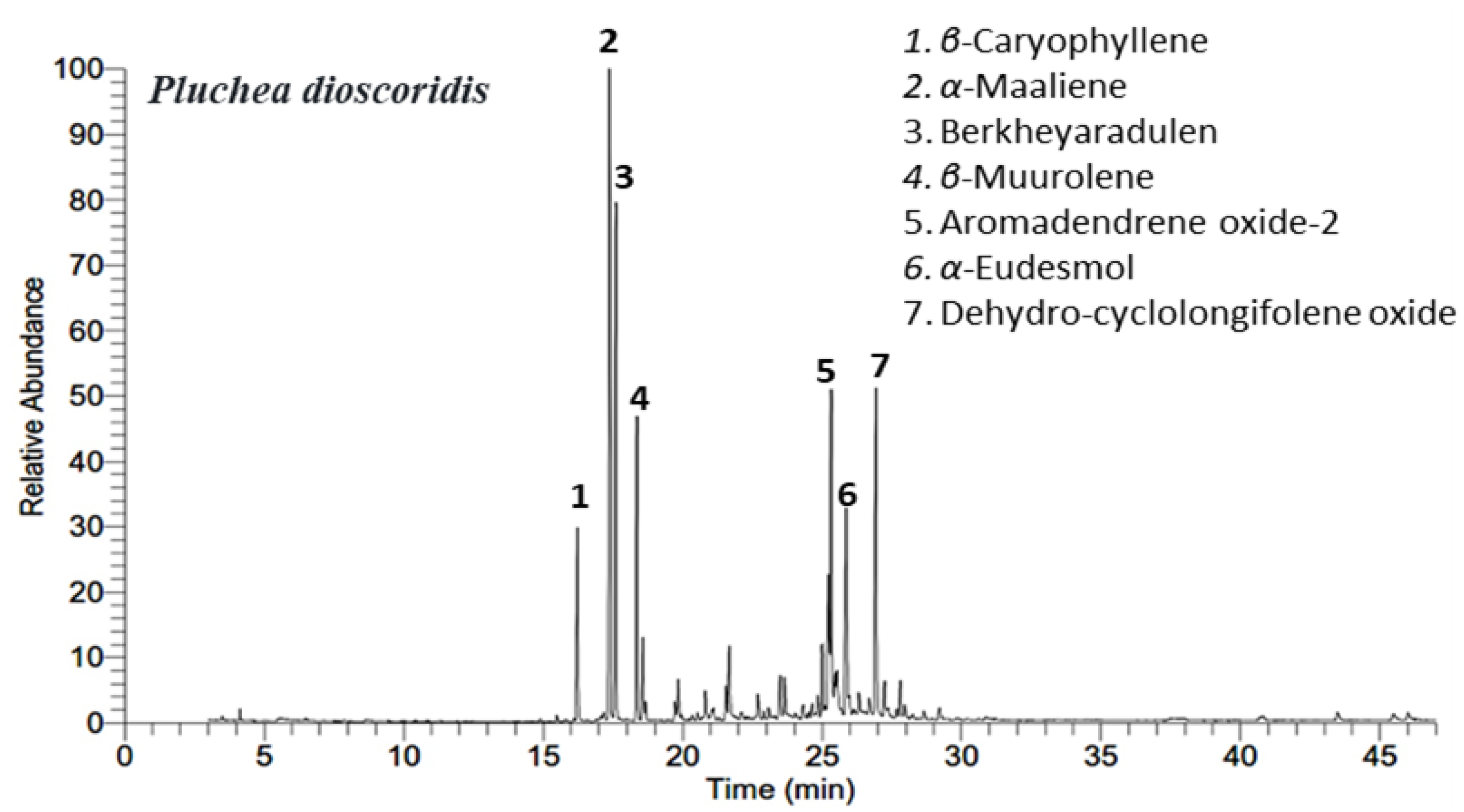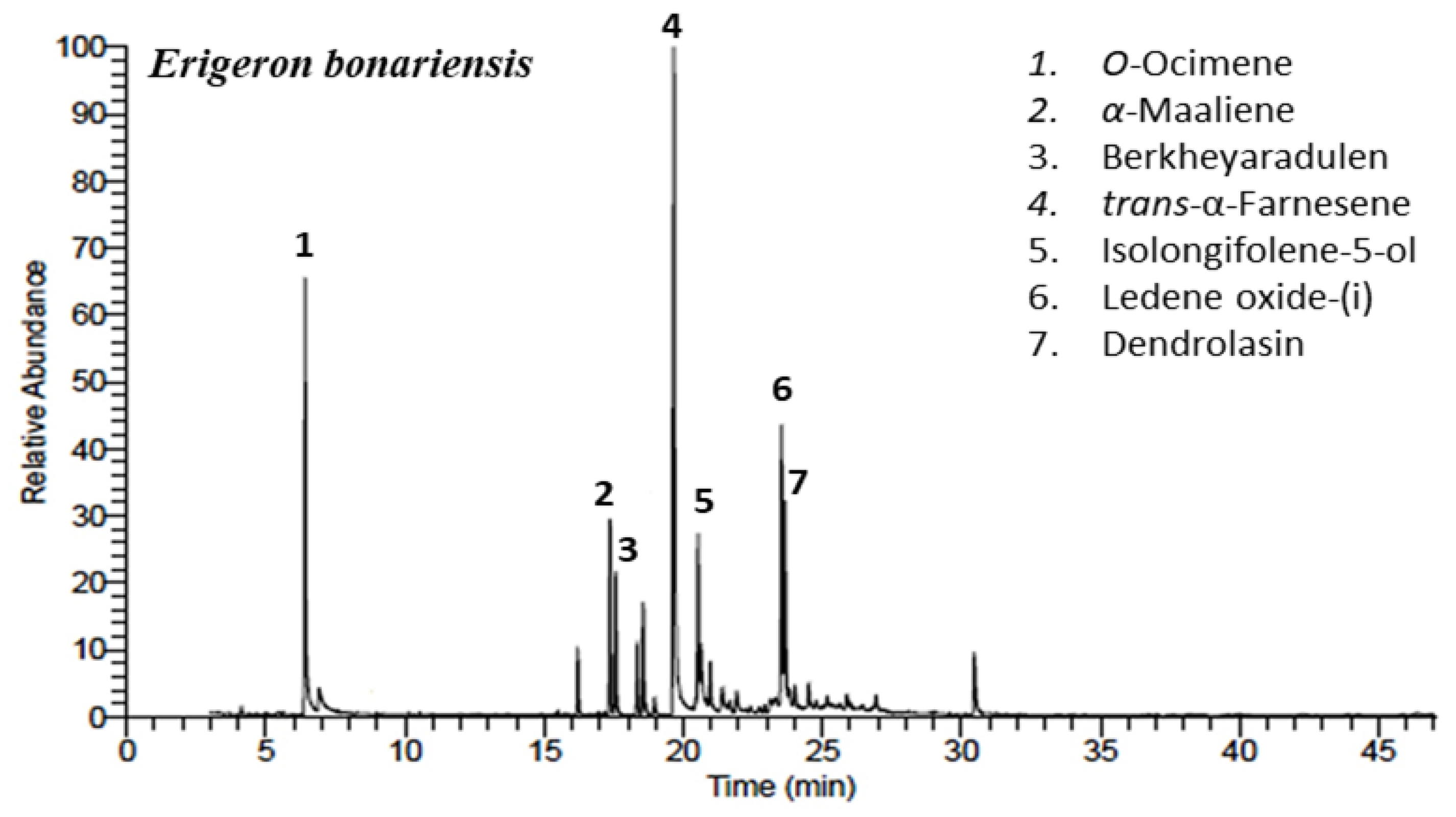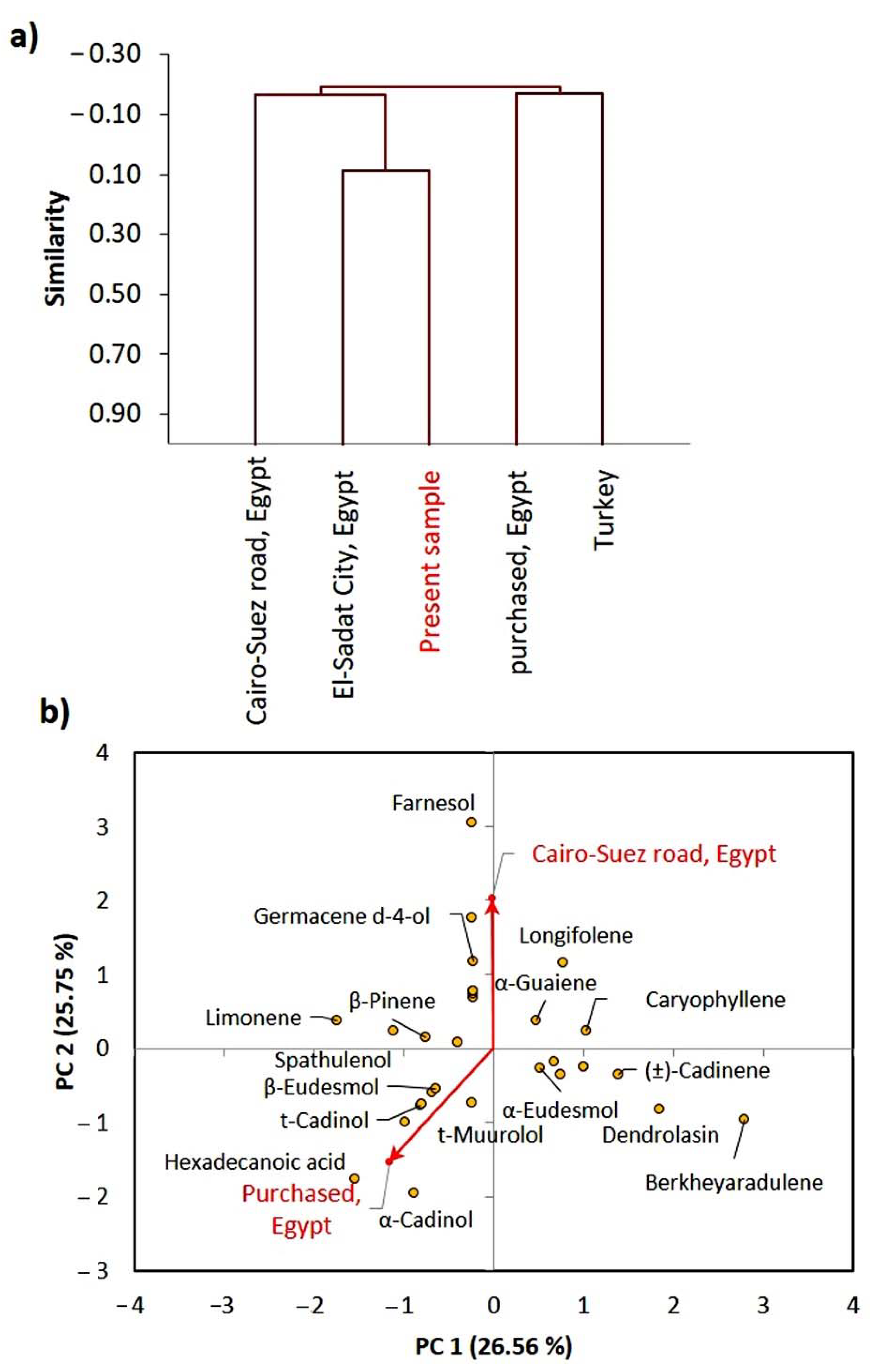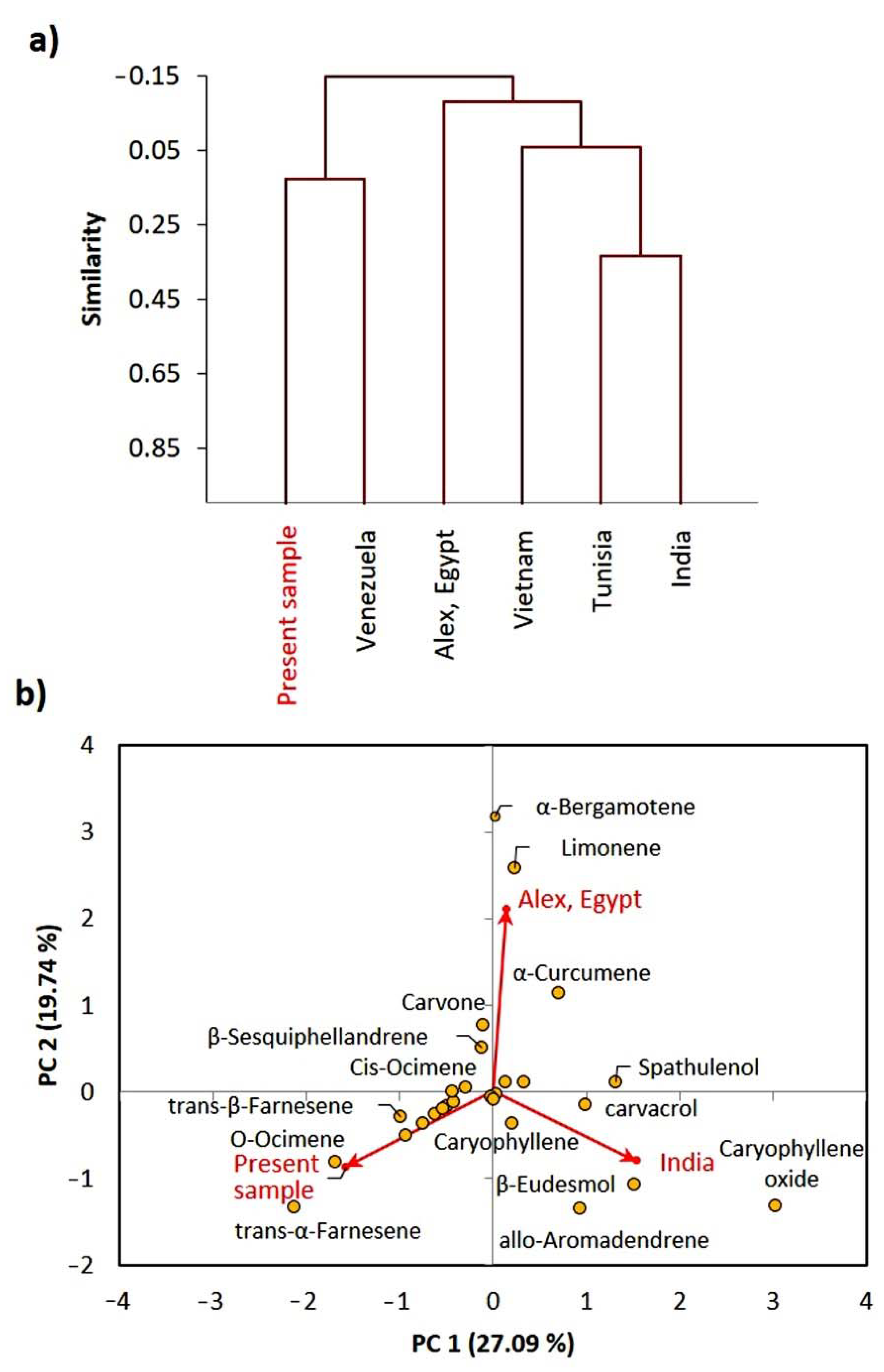Chemical Profiles, Anticancer, and Anti-Aging Activities of Essential Oils of Pluchea dioscoridis (L.) DC. and Erigeron bonariensis L.
Abstract
1. Introduction
2. Results and Discussion
2.1. Chemical Compositions of EO of P. dioscoridis
2.2. Chemical Compositions of EO of E. bonariensis
2.3. Chemometric Analysis
2.4. Anti-Aging Activity
2.5. Cytotoxic Activity of EOs of P. dioscoridis and E. bonariensis
3. Materials and Methods
3.1. Plant Materials Collection and Preparation
3.2. Extraction of EOs
3.3. Gas Chromatography-Mass Spectroscopy (GC-MS) Analysis and Chemical Components Investigations
3.4. Anti-Aging Activity of the EOs
3.4.1. Anti-Collagenase Assay
3.4.2. Anti-Elastase Assay
3.4.3. Anti-Tyrosinase Assay
3.4.4. Anti-Hyaluronidase Assay
3.5. Cytotoxicity of the Two EOs
3.5.1. Cell Culture
3.5.2. Cytotoxicity Assay
3.6. Data Treatment
4. Conclusions
Author Contributions
Funding
Institutional Review Board Statement
Informed Consent Statement
Data Availability Statement
Acknowledgments
Conflicts of Interest
Sample Availability
References
- Cseke, L.J.; Kirakosyan, A.; Kaufman, P.B.; Warber, S.; Duke, J.A.; Brielmann, H.L. Natural Products from Plants; CRC Press: Boca Raton, FL, USA, 2016. [Google Scholar]
- Abdallah, H.M.I.; Elshamy, A.I.; El Gendy, A.E.-N.G.; Abd El-Gawad, A.M.; Omer, E.A.; De Leo, M.; Pistelli, L. Anti-inflammatory, antipyretic, and antinociceptive effects of a Cressa cretica aqueous extract. Planta Med. 2017, 83, 1313–1320. [Google Scholar] [CrossRef] [PubMed]
- Edris, A.E. Pharmaceutical and therapeutic potentials of essential oils and their individual volatile constituents: A review. Phytother. Res. 2007, 21, 308–323. [Google Scholar] [CrossRef] [PubMed]
- Della Pepa, T.; Elshafie, H.S.; Capasso, R.; De Feo, V.; Camele, I.; Nazzaro, F.; Scognamiglio, M.R.; Caputo, L. Antimicrobial and phytotoxic activity of Origanum heracleoticum and O. majorana essential oils growing in Cilento (Southern Italy). Molecules 2019, 24, 2576. [Google Scholar] [CrossRef]
- Gruľová, D.; Caputo, L.; Elshafie, H.S.; Baranová, B.; De Martino, L.; Sedlák, V.; Gogaľová, Z.; Poráčová, J.; Camele, I.; De Feo, V. Thymol chemotype Origanum vulgare L. essential oil as a potential selective bio-based herbicide on monocot plant species. Molecules 2020, 25, 595. [Google Scholar] [CrossRef] [PubMed]
- Al-Rowaily, S.L.; Abd-ElGawad, A.M.; Assaeed, A.M.; Elgamal, A.M.; Gendy, A.E.-N.G.E.; Mohamed, T.A.; Dar, B.A.; Mohamed, T.K.; Elshamy, A.I. Essential oil of Calotropis procera: Comparative chemical profiles, antimicrobial activity, and allelopathic potential on weeds. Molecules 2020, 25, 5203. [Google Scholar] [CrossRef]
- Abd El-Gawad, A.; El Gendy, A.; Elshamy, A.; Omer, E. Chemical composition of the essential oil of Trianthema portulacastrum L. Aerial parts and potential antimicrobial and phytotoxic activities of its extract. J. Essent. Oil Bear. Plants 2016, 19, 1684–1692. [Google Scholar] [CrossRef]
- Elshamy, A.I.; Ammar, N.M.; Hassan, H.A.; Al-Rowaily, S.L.; Ragab, T.I.; El Gendy, A.E.-N.G.; Abd-ElGawad, A.M. Essential oil and its nanoemulsion of Araucaria heterophylla resin: Chemical characterization, anti-inflammatory, and antipyretic activities. Ind. Crops Prod. 2020, 148, 112272. [Google Scholar] [CrossRef]
- Abd-ElGawad, A.M.; Elshamy, A.I.; El-Nasser El Gendy, A.; Al-Rowaily, S.L.; Assaeed, A.M. Preponderance of oxygenated sesquiterpenes and diterpenes in the volatile oil constituents of Lactuca serriola L. revealed antioxidant and allelopathic activity. Chem. Biodivers. 2019, 16, e1900278. [Google Scholar] [CrossRef]
- Assaeed, A.; Elshamy, A.; El Gendy, A.E.-N.; Dar, B.; Al-Rowaily, S.; Abd-ElGawad, A. Sesquiterpenes-rich essential oil from above ground parts of Pulicaria somalensis exhibited antioxidant activity and allelopathic effect on weeds. Agronomy 2020, 10, 399. [Google Scholar] [CrossRef]
- Elshamy, A.I.; Abd-ElGawad, A.M.; El-Amier, Y.A.; El Gendy, A.E.N.G.; Al-Rowaily, S.L. Interspecific variation, antioxidant and allelopathic activity of the essential oil from three Launaea species growing naturally in heterogeneous habitats in Egypt. Flavour Fragr. J. 2019, 34, 316–328. [Google Scholar] [CrossRef]
- Abd El-Gawad, A.M.; El-Amier, Y.A.; Bonanomi, G. Essential oil composition, antioxidant and allelopathic activities of Cleome droserifolia (Forssk.) Delile. Chem. Biodivers. 2018, 15, e1800392. [Google Scholar] [CrossRef]
- Abd El-Gawad, A.M. Chemical constituents, antioxidant and potential allelopathic effect of the essential oil from the aerial parts of Cullen plicata. Ind. Crops Prod. 2016, 80, 36–41. [Google Scholar] [CrossRef]
- Abd-ElGawad, A.M.; El Gendy, A.E.-N.G.; Assaeed, A.M.; Al-Rowaily, S.L.; Alharthi, A.S.; Mohamed, T.A.; Nassar, M.I.; Dewir, Y.H.; Elshamy, A.I. Phytotoxic effects of plant essential oils: A systematic review and structure-activity relationship based on chemometric analyses. Plants 2021, 10, 36. [Google Scholar] [CrossRef] [PubMed]
- Abd-ElGawad, A.M.; El Gendy, A.E.-N.G.; Assaeed, A.M.; Al-Rowaily, S.L.; Omer, E.A.; Dar, B.A.; Al-Taisan, W.a.A.; Elshamy, A.I. Essential oil enriched with oxygenated constituents from invasive plant Argemone ochroleuca exhibited potent phytotoxic effects. Plants 2020, 9, 998. [Google Scholar] [CrossRef] [PubMed]
- Abd El-Gawad, A.M.; El-Amier, Y.A.; Bonanomi, G. Allelopathic activity and chemical composition of Rhynchosia minima (L.) DC. essential oil from Egypt. Chem. Biodivers. 2018, 15, e1700438. [Google Scholar] [CrossRef]
- Elshamy, A.I.; Abd-ElGawad, A.M.; El Gendy, A.E.N.G.; Assaeed, A.M. Chemical characterization of Euphorbia heterophylla L. essential oils and their antioxidant activity and allelopathic potential on Cenchrus echinatus L. Chem. Biodivers. 2019, 16, e1900051. [Google Scholar] [CrossRef]
- Arunachalam, K.; Balogun, S.O.; Pavan, E.; de Almeida, G.V.B.; de Oliveira, R.G.; Wagner, T.; Cechinel Filho, V.; de Oliveira Martins, D.T. Chemical characterization, toxicology and mechanism of gastric antiulcer action of essential oil from Gallesia integrifolia (Spreng.) Harms in the in vitro and in vivo experimental models. Biomed. Pharmacother. 2017, 94, 292–306. [Google Scholar] [CrossRef] [PubMed]
- Saleh, I.; Abd-ElGawad, A.; El Gendy, A.E.-N.; Abd El Aty, A.; Mohamed, T.; Kassem, H.; Aldosri, F.; Elshamy, A.; Hegazy, M.-E.F. Phytotoxic and antimicrobial activities of Teucrium polium and Thymus decussatus essential oils extracted using hydrodistillation and microwave-assisted techniques. Plants 2020, 9, 716. [Google Scholar] [CrossRef] [PubMed]
- Damtie, D.; Braunberger, C.; Conrad, J.; Mekonnen, Y.; Beifuss, U. Composition and hepatoprotective activity of essential oils from Ethiopian thyme species (Thymus serrulatus and Thymus schimperi). J. Essent. Oil Res. 2019, 31, 120–128. [Google Scholar] [CrossRef]
- Tomaino, A.; Cimino, F.; Zimbalatti, V.; Venuti, V.; Sulfaro, V.; De Pasquale, A.; Saija, A. Influence of heating on antioxidant activity and the chemical composition of some spice essential oils. Food Chem. 2005, 89, 549–554. [Google Scholar] [CrossRef]
- Wang, A.; Wu, H.; Zhu, X.; Lin, J. Species identification of Conyza bonariensis assisted by chloroplast genome sequencing. Front. Genet. 2018, 9, 374. [Google Scholar] [CrossRef]
- Peng, L.; Hu, C.; Zhang, C.; Lu, Y.; Man, S.; Ma, L. Anti-cancer activity of Conyza blinii saponin against cervical carcinoma through MAPK/TGF-β/Nrf2 signaling pathways. J. Ethnopharmacol. 2020, 251, 112503. [Google Scholar] [CrossRef]
- Ayaz, F.; Küçükboyacı, N.; Demirci, B. Chemical composition and antimicrobial activity of the essential oil of Conyza canadensis (L.) Cronquist from Turkey. J. Essent. Oil Res. 2017, 29, 336–343. [Google Scholar] [CrossRef]
- Boulos, L. Flora of Egypt; Al Hadara Publishing: Cairo, Egypt, 2002; Volume 3. [Google Scholar]
- List, T.P. Version 1.1. Available online: http://www.theplantlist.org/ (accessed on 1 January 2013).
- Abd El-Gawad, A.; Elshamy, A.; El Gendy, A.E.-N.; Gaara, A.; Assaeed, A. Volatiles profiling, allelopathic activity, and antioxidant potentiality of Xanthium strumarium leaves essential oil from Egypt: Evidence from chemometrics analysis. Molecules 2019, 24, 584. [Google Scholar] [CrossRef]
- El-Taher, A.M.; Gendy, A.E.-N.G.E.; Alkahtani, J.; Elshamy, A.I.; Abd-ElGawad, A.M. Taxonomic implication of integrated chemical, morphological, and anatomical attributes of leaves of eight Apocynaceae taxa. Diversity 2020, 12, 334. [Google Scholar] [CrossRef]
- Mohamed, T.A.; Elshamy, A.I.; Abd-ElGawad, A.M.; Hussien, T.A.; El-Toumy, S.A.; Efferth, T.; Hegazy, M.E.F. Cytotoxic and chemotaxonomic study of isolated metabolites from Centaurea aegyptiaca. J. Chin. Chem. Soc. 2021, 68, 159–168. [Google Scholar] [CrossRef]
- El Zalabani, S.; Hetta, M.; Ross, S.; Abo Youssef, A.; Zakiand, M.; Ismail, A. Antihyperglycemic and antioxidant activities and chemical composition of Conyza dioscoridis (L.) Desf. DC. growing in Egypt. Aust. J. Basic Appl. Sci. 2012, 6, 257–265. [Google Scholar]
- Atta, A.H.; Nasr, S.M.; Mouneir, S.; Alwabel, N.; Essawy, S. Evaluation of the diuretic effect of Conyza dioscorides and Alhagi maurorum. Int. J. Pharm. Pharm. Sci. 2010, 2, 162–165. [Google Scholar]
- Elshamy, A.I.; El Gendy, A.; Farrag, A.; Nassar, M.I. Antidiabetic and antioxidant activities of phenolic extracts of Conyza dioscoridis L. shoots. Int. J. Pharm. Pharm. Sci. 2015, 7, 65–72. [Google Scholar]
- Awaad, A.S.; El-Meligy, R.; Qenawy, S.; Atta, A.; Soliman, G.A. Anti-inflammatory, antinociceptive and antipyretic effects of some desert plants. J. Saudi Chem. Soc. 2011, 15, 367–373. [Google Scholar] [CrossRef]
- Harraz, F.M.; Hammoda, H.M.; El Ghazouly, M.G.; Farag, M.A.; El-Aswad, A.F.; Bassam, S.M. Chemical composition, antimicrobial and insecticidal activities of the essential oils of Conyza linifolia and Chenopodium ambrosioides. Nat. Prod. Res. 2015, 29, 879–882. [Google Scholar] [CrossRef]
- Atta, A.H.; Mouneir, S.M. Antidiarrhoeal activity of some Egyptian medicinal plant extracts. J. Ethnopharmacol. 2004, 92, 303–309. [Google Scholar] [CrossRef] [PubMed]
- Adams, R.P. Identification of Essential Oil Components By Gas Chromatography/Mass Spectrometry; Allured Publishing Corporation: Carol Stream, IL, USA, 2007; Volume 456. [Google Scholar]
- Mabrouk, S.; Elaissi, A.; Ben Jannet, H.; Harzallah-Skhiri, F. Chemical composition of essential oils from leaves, stems, flower heads and roots of Conyza bonariensis L. from Tunisia. Nat. Prod. Res. 2011, 25, 77–84. [Google Scholar] [CrossRef] [PubMed]
- El-Seedi, H.R.; Azeem, M.; Khalil, N.S.; Sakr, H.H.; Khalifa, S.A.; Awang, K.; Saeed, A.; Farag, M.A.; AlAjmi, M.F.; Pålsson, K. Essential oils of aromatic Egyptian plants repel nymphs of the tick Ixodes ricinus (Acari: Ixodidae). Exp. Appl. Acarol. 2017, 73, 139–157. [Google Scholar] [CrossRef]
- Lis, A.; Góra, J. Essential oil of Conyza canadensis (L.) Cronq. J. Essent. Oil Res. 2000, 12, 781–783. [Google Scholar] [CrossRef]
- Araujo, L.; Moujir, L.M.; Rojas, J.; Rojas, L.; Carmona, J.; Rondón, M. Chemical composition and biological activity of Conyza bonariensis essential oil collected in Mérida, Venezuela. Nat. Prod. Commun. 2013, 8, 1175–1178. [Google Scholar] [CrossRef]
- Hoi, T.M.; Huong, L.T.; Chinh, H.V.; Hau, D.V.; Satyal, P.; Tai, T.A.; Dai, D.N.; Hung, N.H.; Hien, V.T.; Setzer, W.N. Essential oil compositions of three invasive Conyza species collected in Vietnam and their larvicidal activities against Aedes aegypti, Aedes albopictus, and Culex quinquefasciatus. Molecules 2020, 25, 4576. [Google Scholar] [CrossRef]
- Abd-ElGawad, A.M.; Elshamy, A.I.; El-Amier, Y.A.; El Gendy, A.E.-N.G.; Al-Barati, S.A.; Dar, B.A.; Al-Rowaily, S.L.; Assaeed, A.M. Chemical composition variations, allelopathic, and antioxidant activities of Symphyotrichum squamatum (Spreng.) Nesom essential oils growing in heterogeneous habitats. Arab. J. Chem. 2020, 13, 4237–4245. [Google Scholar] [CrossRef]
- Abd-ElGawad, A.M.; Elshamy, A.I.; Al-Rowaily, S.L.; El-Amier, Y.A. Habitat affects the chemical profile, allelopathy, and antioxidant properties of essential oils and phenolic enriched extracts of the invasive plant Heliotropium curassavicum. Plants 2019, 8, 482. [Google Scholar] [CrossRef] [PubMed]
- Xiong, L.-G.; Chen, Y.-J.; Tong, J.-W.; Gong, Y.-S.; Huang, J.-A.; Liu, Z.-H. Epigallocatechin-3-gallate promotes healthy lifespan through mitohormesis during early-to-mid adulthood in Caenorhabditis elegans. Redox Biol. 2018, 14, 305–315. [Google Scholar] [CrossRef]
- Tu, P.T.B.; Tawata, S. Anti-oxidant, anti-aging, and anti-melanogenic properties of the essential oils from two varieties of Alpinia zerumbet. Molecules 2015, 20, 16723–16740. [Google Scholar] [CrossRef] [PubMed]
- Pandey, S.; Tiwari, S.; Kumar, A.; Niranjan, A.; Chand, J.; Lehri, A.; Chauhan, P.S. Antioxidant and anti-aging potential of Juniper berry (Juniperus communis L.) essential oil in Caenorhabditis elegans model system. Ind. Crops Prod. 2018, 120, 113–122. [Google Scholar] [CrossRef]
- Laothaweerungsawat, N.; Sirithunyalug, J.; Chaiyana, W. Chemical compositions and anti-skin-ageing activities of Origanum vulgare L. essential oil from tropical and mediterranean region. Molecules 2020, 25, 1101. [Google Scholar] [CrossRef]
- Pezzani, R.; Salehi, B.; Vitalini, S.; Iriti, M.; Zuñiga, F.A.; Sharifi-Rad, J.; Martorell, M.; Martins, N. Synergistic effects of plant derivatives and conventional chemotherapeutic agents: An update on the cancer perspective. Medicina 2019, 55, 110. [Google Scholar] [CrossRef]
- Mohamed, T.A.; Albadry, H.A.; Elshamy, A.I.; Younes, S.H.; Shahat, A.A.; El-wassimy, M.T.; Moustafa, M.F.; Hegazy, M.E.F. A new Tetrahydrofuran sesquiterpene skeleton from Artemisia sieberi. J. Chin. Chem. Soc. 2020, 86, 1–5. [Google Scholar] [CrossRef]
- Xie, Z.Q.; Ding, L.F.; Wang, D.S.; Nie, W.; Liu, J.X.; Qin, J.; Song, L.D.; Wu, X.D.; Zhao, Q.S. Sesquiterpenes from the leaves of Magnolia delavayi Franch. and their cytotoxic activities. Chem. Biodivers. 2019, 16, e1900013. [Google Scholar] [CrossRef]
- Blowman, K.; Magalhães, M.; Lemos, M.F.L.; Cabral, C.; Pires, I.M. Anticancer properties of essential oils and other natural products. J. Evid. Based Compl. Altern. Med. 2018, 2018, 3149362. [Google Scholar] [CrossRef]
- Danin, A. Plants of Desert Dunes; Springer Science & Business Media: Berlin, Germany, 2012. [Google Scholar]
- Wright, B.S.; Bansal, A.; Moriarity, D.M.; Takaku, S.; Setzer, W.N. Cytotoxic leaf essential oils from Neotropical Lauraceae: Synergistic effects of essential oil components. Nat. Prod. Commun. 2007, 2, 1241–1244. [Google Scholar] [CrossRef]
- Ali, N.A.A.; Chhetri, B.K.; Dosoky, N.S.; Shari, K.; Al-Fahad, A.J.; Wessjohann, L.; Setzer, W.N. Antimicrobial, antioxidant, and cytotoxic activities of Ocimum forskolei and Teucrium yemense (Lamiaceae) essential oils. Medicines 2017, 4, 17. [Google Scholar] [CrossRef]
- Loizzo, M.R.; Tundis, R.; Menichini, F.; Saab, A.M.; Statti, G.A.; Menichini, F. Cytotoxic activity of essential oils from Labiatae and Lauraceae families against in vitro human tumor models. Anticancer Res. 2007, 27, 3293–3299. [Google Scholar] [PubMed]
- Elgndi, M.A.; Filip, S.; Pavlić, B.; Vladić, J.; Stanojković, T.; Žižak, Ž.; Zeković, Z. Antioxidative and cytotoxic activity of essential oils and extracts of Satureja montana L., Coriandrum sativum L. and Ocimum basilicum L. obtained by supercritical fluid extraction. J. Supercrit. Fluids 2017, 128, 128–137. [Google Scholar] [CrossRef]
- Haroun, M.F.; Al-Kayali, R.S. Synergistic effect of Thymbra spicata L. extracts with antibiotics against multidrug-resistant Staphylococcus aureus and Klebsiella pneumoniae strains. Iran. J. Basic Med. Sci. 2016, 19, 1193–1200. [Google Scholar]
- Tackholm, V. Students’ Flora of Egypt, 2nd ed.; Cairo University Press: Cairo, Egypt, 1974. [Google Scholar]
- Thring, T.S.A.; Hili, P.; Naughton, D.P. Anti-collagenase, anti-elastase and anti-oxidant activities of extracts from 21 plants. BMC Compl. Altern. Med. 2009, 9, 27. [Google Scholar] [CrossRef]
- Kim, Y.-J.; Uyama, H.; Kobayashi, S. Inhibition effects of (+)-catechin–aldehyde polycondensates on proteinases causing proteolytic degradation of extracellular matrix. Biochem. Biophys. Res. Commun. 2004, 320, 256–261. [Google Scholar] [CrossRef] [PubMed]
- Batubara, I.; Darusman, L.; Mitsunaga, T.; Rahminiwati, M.; Djauhari, E. Potency of Indonesian medicinal plants as tyrosinase inhibitor and antioxidant agent. J. Biol. Sci. 2010, 10, 138–144. [Google Scholar] [CrossRef]
- Reissig, J.L.; Strominger, J.L.; Leloir, L.F. A modified colorimetric method for the estimation of N-acetylamino sugars. J. Biol. Chem. 1955, 217, 959–966. [Google Scholar] [CrossRef]
- Takahashi, T.; Ikegami-Kawai, M.; Okuda, R.; Suzuki, K. A fluorimetric Morgan–Elson assay method for hyaluronidase activity. Anal. Biochem. 2003, 322, 257–263. [Google Scholar] [CrossRef] [PubMed]
- Skehan, P.; Storeng, R.; Scudiero, D.; Monks, A.; McMahon, J.; Vistica, D.; Warren, J.T.; Bokesch, H.; Kenney, S.; Boyd, M.R. New colorimetric cytotoxicity assay for anticancer-drug screening. J. Natl. Cancer Inst. 1990, 82, 1107–1112. [Google Scholar] [CrossRef] [PubMed]
- Allam, R.M.; Al-Abd, A.M.; Khedr, A.; Sharaf, O.A.; Nofal, S.M.; Khalifa, A.E.; Mosli, H.A.; Abdel-Naim, A.B. Fingolimod interrupts the cross talk between estrogen metabolism and sphingolipid metabolism within prostate cancer cells. Toxicol. Lett. 2018, 291, 77–85. [Google Scholar] [CrossRef]






| No | Rt [a] | Compound Name | MF | KILit [b] | KIExp [c] | Relative Concentration % | |
|---|---|---|---|---|---|---|---|
| P. discodirdis | E. bonariensis | ||||||
| Monoterpenes | 0.19% | 14.16% | |||||
| 1 | 4.13 | α-Pinene | C10H16 | 933 | 934 | 0.19 ± 0.01 | 0.18 ± 0.01 |
| 2 | 5.43 | α-Myrcene | C10H16 | 991 | 990 | ------ | 0.20 ± 0.01 |
| 3 | 6.41 | O-Ocimene | C10H16 | 1012 | 1012 | ------ | 12.58 ± 0.09 |
| 4 | 6.91 | D-Limonene | C10H16 | 1035 | 1036 | ------ | 1.20 ± 0.04 |
| Sesquiterpenes | 93.4% | 81.06% | |||||
| 5 | 16.22 | β-Caryophyllene | C15H24 | 1418 | 1420 | 4.95 ± 0.07 | 2.17 ± 0.04 |
| 6 | 16.96 | Aromandendrene | C15H24 | 1439 | 1448 | ------ | 0.12 ± 0.03 |
| 7 | 17.17 | α-Guaiene | C15H24 | 1439 | 1439 | 0.21 ± 0.02 | 0.11 ± 0.02 |
| 8 | 17.39 | α-Maaliene | C15H24 | 1480 | 1479 | 18.84 ± 0.08 | 6.64 ± 0.09 |
| 9 | 17.60 | Berkheyaradulen | C15H24 | 1492 | 1493 | 13.99 ± 0.09 | 4.82 ± 0.06 |
| 10 | 18.36 | β-Muurolene | C15H24 | 1493 | 1493 | 8.09 ± 0.05 | 2.37 ± 0.04 |
| 11 | 18.57 | α-Muurolene | C15H24 | 1498 | 1499 | 2.20 ± 0.04 | 3.99 ± 0.07 |
| 12 | 18.98 | Bicyclogermacrene | C15H24 | 1500 | 1501 | ------ | 0.66 ± 0.01 |
| 13 | 19.67 | trans-α-Farnesene | C15H24 | 1508 | 1507 | ------ | 25.03 ± 0.13 |
| 14 | 19.73 | α-Bisabolene | C15H24 | 1509 | 1511 | 0.58 ± 0.03 | ------ |
| 15 | 19.84 | γ-Cadinene | C15H24 | 1514 | 1515 | 1.36 ± 0.04 | ------ |
| 16 | 20.35 | α-Sesquiphellandrene | C15H24 | 1516 | 1517 | 0.44 ± 0.01 | ------ |
| 17 | 20.45 | cis-Lanceol | C15H24O | 1525 | 1527 | 0.16 ± 0.02 | 0.09 ± 0.01 |
| 18 | 20.54 | Isolongifolene-5-ol | C15H24O | 1534 | 1535 | 0.19 ± 0.01 | 5.53 ± 0.07 |
| 19 | 20.64 | Germacrene D-4-ol | C15H24 | 1574 | 1576 | ------ | 2.35 ± 0.04 |
| 20 | 20.81 | Spathulenol | C15H24O | 1576 | 1577 | 0.81 ± 0.03 | 0.10 ± 0.01 |
| 21 | 20.98 | Isoaromadendrene epoxide | C15H24O | 1580 | 1579 | ------ | 1.50 ± 0.03 |
| 22 | 21.41 | Calarenepoxide | C15H24O | 1592 | 1592 | ------ | 1.07 ± 0.02 |
| 23 | 21.56 | Caryophyllene oxide | C15H24O | 1594 | 1593 | 0.86 ± 0.02 | 0.08 ± 0.01 |
| 24 | 21.66 | Salvial-4(14)-en-1-one | C15H24O | 1595 | 1595 | 2.20 ± 0.04 | 0.38 ± 0.01 |
| 25 | 21.93 | Ledene alcohol | C15H24O | 1729 | 1731 | ------ | 0.97 ± 0.03 |
| 26 | 22.1 | Carotol | C15H26O | 1597 | 1598 | 0.78 ± 0.02 | ------ |
| 27 | 22.42 | Humuladienone | C15H24O | 1607 | 1605 | ------ | 0.32 ± 0.01 |
| 28 | 23.09 | Neoclovenoxid | C15H24O | 1608 | 1610 | 0.90 ± 0.02 | 0.51 ± 0.03 |
| 29 | 23.33 | Cubenol | C15H26O | 1642 | 1642 | ------ | 0.74 ± 0.02 |
| 30 | 23.49 | Farnesol | C15H26O | 1722 | 1720 | 1.35 ± 0.05 | ------ |
| 31 | 23.55 | Ledene oxide-(i) | C15H24O | 1668 | 1667 | ------ | 10.93 ± 0.10 |
| 32 | 23.65 | Dendrolasin | C15H22O | 1574 | 1575 | 2.85 ± 0.06 | 8.37 ± 0.09 |
| 33 | 23.81 | Torreyol | C15H26O | 1645 | 1644 | ------ | 0.55 ± 0.02 |
| 34 | 25 | Isospathulenol | C15H24O | 1625 | 1627 | 1.90 ± 0.05 | ------ |
| 35 | 25.22 | tau-Muurolol | C15H26O | 1646 | 1646 | 3.88 ± 0.08 | 0.51 ± 0.03 |
| 36 | 25.32 | Aromadendrene oxide-2 | C15H24O | 1650 | 1649 | 8.81 ± 0.11 | 0.38 ± 0.02 |
| 37 | 25.85 | α-Eudesmol | C15H26O | 1652 | 1653 | 6.79 ± 0.08 | 0.77 ± 0.01 |
| 38 | 26.69 | γ-Cadinol | C15H26O | 1654 | 1655 | 0.91 ± 0.04 | ------ |
| 39 | 26.92 | Dehydro-cyclolongifolene oxide | C15H24O | 1657 | 1658 | 10.35 ± 0.12 | ------ |
| Diterpenes | ------ | 2.44% | |||||
| 40 | 30.47 | Neophytadiene | C20H38 | 1840 | 1840 | ------ | 2.44 |
| Carotenoids derived compounds | 0.28% | ------ | |||||
| 41 | 27.36 | α-Ionone | C13H20O | 1426 | 1426 | 0.28 ± 0.01 | ------ |
| Others | 1.33% | 0.55% | |||||
| 42 | 18.66 | 1-Butanone, 1-(2,3,4,5-tetramethylphenyl)- | C14H20O | 1660 | 1661 | 0.46 ± 0.03 | 0.32 ± 0.02 |
| 43 | 26.32 | Methyl 2,5-octadecadiynoate | C19H30O2 | 1980 | 1980 | 0.64 ± 0.03 | 0.13 ± 0.01 |
| 44 | 42.28 | n-Pentacosane | C25H52 | 2500 | 2500 | ------ | 0.10 ± 0.01 |
| 45 | 45.48 | n-Heptacosane | C27H56 | 2700 | 2700 | 0.23±0.01 | ------ |
| Total | 96.91% | 98.21% | |||||
Publisher’s Note: MDPI stays neutral with regard to jurisdictional claims in published maps and institutional affiliations. |
© 2021 by the authors. Licensee MDPI, Basel, Switzerland. This article is an open access article distributed under the terms and conditions of the Creative Commons Attribution (CC BY) license (https://creativecommons.org/licenses/by/4.0/).
Share and Cite
Elgamal, A.M.; Ahmed, R.F.; Abd-ElGawad, A.M.; El Gendy, A.E.-N.G.; Elshamy, A.I.; Nassar, M.I. Chemical Profiles, Anticancer, and Anti-Aging Activities of Essential Oils of Pluchea dioscoridis (L.) DC. and Erigeron bonariensis L. Plants 2021, 10, 667. https://doi.org/10.3390/plants10040667
Elgamal AM, Ahmed RF, Abd-ElGawad AM, El Gendy AE-NG, Elshamy AI, Nassar MI. Chemical Profiles, Anticancer, and Anti-Aging Activities of Essential Oils of Pluchea dioscoridis (L.) DC. and Erigeron bonariensis L. Plants. 2021; 10(4):667. https://doi.org/10.3390/plants10040667
Chicago/Turabian StyleElgamal, Abdelbaset M., Rania F. Ahmed, Ahmed M. Abd-ElGawad, Abd El-Nasser G. El Gendy, Abdelsamed I. Elshamy, and Mahmoud I. Nassar. 2021. "Chemical Profiles, Anticancer, and Anti-Aging Activities of Essential Oils of Pluchea dioscoridis (L.) DC. and Erigeron bonariensis L." Plants 10, no. 4: 667. https://doi.org/10.3390/plants10040667
APA StyleElgamal, A. M., Ahmed, R. F., Abd-ElGawad, A. M., El Gendy, A. E.-N. G., Elshamy, A. I., & Nassar, M. I. (2021). Chemical Profiles, Anticancer, and Anti-Aging Activities of Essential Oils of Pluchea dioscoridis (L.) DC. and Erigeron bonariensis L. Plants, 10(4), 667. https://doi.org/10.3390/plants10040667







